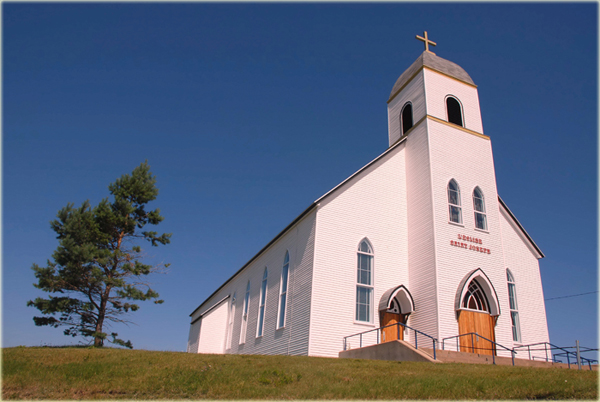Isle Madame, Nova Scotia
Escape from Deportation

Michel Samson Settles on Isle Madame
Tensions between the French and the English in North America continued to escalate, as each battled for supremacy on the continent. In an effort to protect their interests at Ile Royale, the French erected a large fortress at the northern part of the island. It was hoped that the fort of Louisbourg would secure their last remaining stronghold in the Atlantic, as well as protect the mouth of the Saint Lawrence Seaway, gateway to Quebec. English forces overtook the fort in 1745, only to return it three years later. The British finally won the fortress for the last time in 1758.
Following the first Acadian deportation on mainland Nova Scotia in 1755, the French residents of Ile Royale were naturally fearsome for their lives, especially after the fall of Louisbourg. In fact, a second deportation did take place in 1758 and several members of the Samson family were transported to France on the ship “La Reine d’Espagne”. Many did not survive the journey to Europe, especially the young children, and most died en route. When the ship disembarked at St. Malo, France on November 17, 1758, a few more Samson survivors were so ill that they died in the hospitals in the following months. Of the 108 passengers on the “La Reine d’Espagne”, 58 died during the Trans-Atlantic journey. Gabriel’s youngest son, Charles Samson was on board, but died at sea with his two children Pierre and Marguerite. Gabriel’s daughter, Jeanne Samson was also on board with her husband Charles Pinet, and both died at sea.
Gabriel’s eldest son, Michel Samson, his wife Jeanne Testard, and almost all of their children were deported to France in 1758, and most survived the crossing. Michel and Jeanne and a few of their children may have been transported on a different ship, since Jeanne Testard was included in the census of La Rochelle in 1761 and 1762. However, some of Michel and Jeanne’s children were transported on “La Reine d’Espagne”. Their eldest child, Anne “Jeanne” Samson, was on board with her husband Nicolas Prejean, but died before reaching France. Michel’s son, Jean-Amand Samson and his wife Marie-Josephe Bricette were on board, with their two young children Pierre and Michel. The children died at sea, and Marie-Josephe was so ill that she died at St. Malo on November 22, 1758, only 5 days after the ship landed. Jean-Amand was admitted to the hospital on November 18th and released on December 4, 1758. Having lost his entire family and weakened by disease, he died a few months later in St. Malo, on March 30, 1759.
Conditions for the Acadians transported to France were extremely difficult. After living in North America for several generations, the Acadians did not feel “European”, and were culturally distinct and different. Since they depended upon subsidies from the government, their French neighbors often resented them. Finding employment was very difficult, and those who did usually worked in fishing, sailing or farming. Several Acadians decided their only hope was to return to North America, either to their original lands, or to the colony of Louisiana.
After the Treaty of Paris was signed on February 10, 1763, the Acadians in France and elsewhere were allowed to return to Nova Scotia. The policy of the British in 1764 was that the Acadians should be permitted to resettle in detached groups around the province and mingled with English speaking settlers, provided they took the oath of allegiance. Michel Samson and his family crossed the ocean bound for Cape Breton or the islands of St. Pierre & Miquelon. In April 1764, Michel, his wife Jeanne, their sons Fabien and Louis, daughters Judith and Marie-Josephe, and grandchildren Madeleine and Louis Martel were on board the ship “Le Neptune” when it sank off the coast of Newfoundland. The family drowned, and was buried at St. Pierre Island on April 22, 1764. It was such a sad and terrible tragedy that Michel and his wife and children, who had survived the horrific deportation to France and suffered six long years of yearning to return to their home, would perish so close to the shores of their native land. Michel’s daughter Jeanne “Jeannette” Samson and her husband Joseph Martel survived and remained at St. Pierre before returning to Cape Breton on the ship “La Marianne” in 1767. Thus, almost the entire family of the Acadian Samsons was exterminated as a result of the deportations to France.
The only other surviving child of Michel Samson, also named Michel, somehow escaped capture by the British. He was born in Port Toulouse about 1738 and married about 1761, Madeleine Martel, the daughter of Jean- Baptiste Martel and Marie-Josephe Poujet. According to family oral tradition, Michel and his uncle Mathieu Samson’s family, fled Port Toulouse during the second deportation and hid in the woods, where they were cared for by the local Mi’kmaq natives. They led a nomadic existence until 1763, and eventually formed the Acadian community of L’Ardoise. Michel’s marriage to Madeleine was revalidated (officially blessed by a Catholic priest) in L’Ardoise by the traveling missionary, Charles-Francois Bailly on October 3, 1771. A transcription of the marriage record on Page 64 of Bailly’s register is translated as follows:
On October 3, 1771 at Lardoise harbor in Cape Breton, we have rehabilitated the marriages below, originally contracted in the absence of a missionary but in the presence of witnesses, with the permission of Mr. Maillard, grand vicar, and we have given them the nuptial blessing according to the rites of our Holy Roman and Apostolic Church, having had them renew their vows and their mutual consent of marriage. In the presence of Jean Pere, Alexandre Roch, Joseph Martel and several other witnesses: Michel Sampson, son of Michel Sampson and Anne Paris, with Magdeleine Martel, daughter of J. Bap. Martel and Marie Pouget, without any impediments.
Still fearing further persecutions by the British, Michel Samson (the younger) and his family sought a more remote location from L’Ardoise, and settled on Isle Madame in the 1780’s. In a land petition in 1806, Michel requested a survey for a lot he had occupied “for upwards of 20 years”. In 1809, he petitioned for 50 acres on Isle Madame “on the south shore of the Barrasois” in Petit de Grat. His sons Cyprien, Urbain, Magloire and Fabien remained in Petit de Grat, and his son Sebastien settled in Little Arichat (now West Arichat), also on Isle Madame.
Cyprien’s son Sebastien Samson was one of the two original founders of nearby Barachois Saint-Louis (now Louisdale), just opposite Isle Madame on the mainland of Cape Breton. In September 1850, Sebastien and Jean-Marie Marchand left Isle Madame to explore the north shore of Lennox passage. They built a log home in Seal Cove, and returned before winter with their families. The following year the families of Benjamin Linden, Isaie Marchand and Regis Marchand relocated to the new settlement, and in 1856, Sebastien’s brother Joseph “Josue” Samson also settled there with his family. Thus, Michel Samson was the ancestor of the Samsons of Petit de Grat, West Arichat and Louisdale.
Written by Charles A. Samson, December 1997, revised March 2010.
Sources: Stephen A. White, genealogist at the University of Moncton, New Brunswick; “The Acadian Exiles in Saint-Malo”, by Albert Robichaux; “Acadians in France – Volume III”, Reider and Reider; “Catholic Parish church records”, Ile St. Pierre & Miquelon, France; Registre de l’AC. F. Bailly missionary register, and Cape Breton Crown Land Papers.

